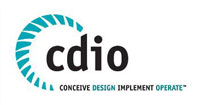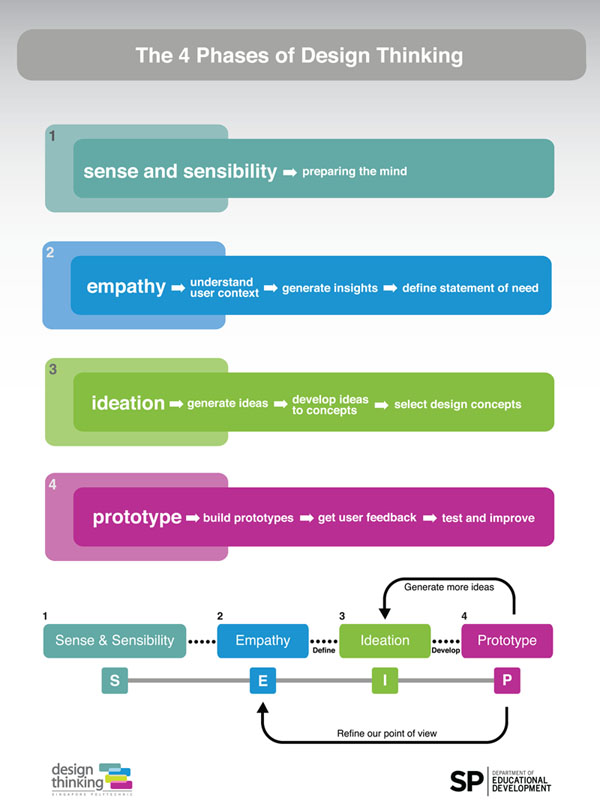Teaching Methods
CDIO

Singapore Polytechnic (SP) is the first educational institution in Asia to be a Conceiving – Designing - Implementing - Operating (CDIO) collaborator in 2004 and has implemented the CDIO framework in its engineering courses successfully in 5 faculty schools and 15 diplomas since 2007. CDIO represents the 4 key stages of most engineering activities and is an engineering education framework developed by Massachusetts Institute of Technology (MIT) and adopted by more than 50 universities worldwide.
The framework focuses strongly on student projects and features active and collaborative learning experiences in both classrooms and workshops or laboratories. It provides students with an education stressing engineering fundamentals set in a context of Conceiving, Designing, Implementing and Operating real-world systems and products.
Developed with input from industry, engineers, alumni and faculty, CDIO equips our engineering students with the technical knowledge, personal and professional skills, and design build experiences to be adaptable and resourceful, good communicators, work comfortably within a team, and have a good blend of theoretical knowledge and practical skills to develop solutions for engineering problems.
In 2010, SP was awarded the Excellence in Education and Training in Chemical Engineering by IChemE (S’pore) for adopting the CDIO framework to deliver the best educational experience to students.
Design Thinking

To be relevant in the workplace, our graduates have to be able to conceive innovative solutions based on real user needs. The Design Thinking process of empathy study of users, ideation, and quick prototyping and co-creation is adopted to strengthen students’ conceiving and designing skills of the CDIO framework.
Recommended by Singapore’s Economic Strategies Committee, Design Thinking uses a range of skills and practices to identify unmet needs and opportunities to create solutions that matter to people. This methodology has been successfully applied not only to technology problems, but also to businesses and social innovations.
“Design thinking is a human-centered approach to innovation that draws from the designer's toolkit to integrate the needs of people, the possibilities of technology, and the requirements for business success.” —Tim Brown, president and CEO
Design Thinking is especially useful for solving challenging problems in our constantly changing world today. Problems which are ill-defined with incomplete, contradictory and changing requirements that are often difficult to recognize and which are interrelated in complex ways. Globalisation, climate change, water security, aging populations and healthcare challenges are just some of the complex problems that we and our students will face in this 21st century.
In 2010, Singapore Polytechnic (SP) started to implement Design Thinking into their organisation. SP created its own Design Thinking framework which consists of four phases and trained lecturers in design thinking workshops and embark on design thinking projects in studio settings.

SP's Design Thinking Framework
The implementation of design thinking in curriculum takes form in the development of multi-disciplinary projects (MDP) where 2nd year students collaborate with other students from different disciplines to work on real-world issues using the design thinking approach. Through MDP, students not only learn the skills of design thinking but also learn to work in teams just as they would after they graduate.

Students work on issues of topics which range from elderly care, health care, social spaces to social innovation. The MDP see students presenting their various prototypes and good solutions will later continue as students’ final year projects.
Intrinsic Motivation
The IM teaching method is based on the works of psychologists and human motivation experts such as Edward Deci, Tom and David Kelley etc. The key focus is to incorporate curriculum activities that encourage competence, relatedness, autonomy, purpose, and the cultivation of a growth mindset.
With close to 16,000 students, SP recognises that we have a diverse student population with a wide range of interests and abilities.
What are the main components of IM?
- Developing self-directed learners
Students learn to set important learning goals; plan and apply appropriate learning strategies; monitor and evaluate their learning; and manage their own motivation to learn. This component empowers them to be:- competent
- relate or connect and belong to a community
- autonomous by giving them a choice and control in their learning.
- Nurturing a growth mindset
Established research shows that a person’s learning attainment is very much based on embracing personal effort, taking on challenges, persisting in the face of difficulties, when working towards mastery of learning goals.
- Developing innovators through play, passion and purpose
This final component empowers and motivates students through 3 key interrelated stages:- Learning through play and experiments
- Mastering key skills and developing passion for their subjects
- Recognising a sense of purpose in lifelong learning